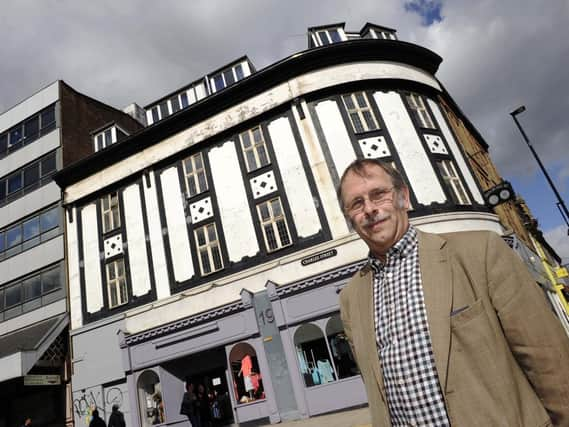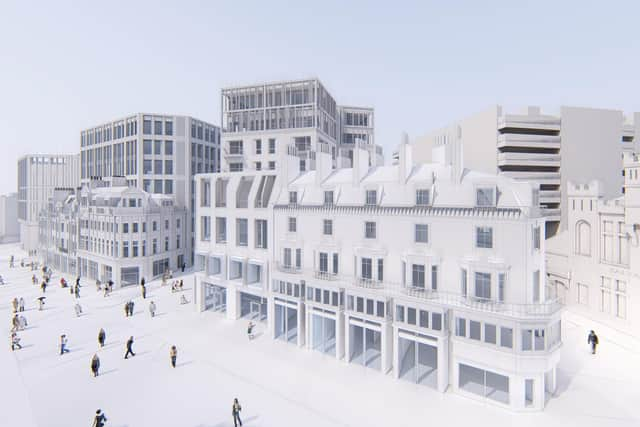Heart of the City 2: Should Sheffield’s past be erased to safeguard its future?


Councillors on the planning board struggled with what they called a “very difficult decision” – should a historic building be demolished to make way for a scheme which will boost Sheffield’s economy? Should the city’s past be erased to safeguard its future?
The building in question is the Athol Hotel, which has been empty for 20 years but played a key role in Sheffield’s sporting heritage.


Advertisement
Hide AdAdvertisement
Hide AdThough built in a time of depression, the Athol Hotel was immediately successful and became a hub for the town’s sporting, political and social life.
Sheffield Football Association held celebratory dinners and meetings there from 1884, the Sheffield Cricket Association was formed there in July 1884, and the Sheffield & District Football League – one of the earliest leagues – was formed there in July 1889.
Conservationist Robin Hughes told the planning meeting: “From 1873 to 1986 were the years of the Long Depression and investors were cautious. However, two plots were sold, the first being on the corner of Charles and Pinstone Streets, bought at a bargain price by the young speculator Henry Bacon Atkinson, founder of the Sheffield Independent.
“By the end of 1883 he had built and opened the Athol Hotel there, which rapidly became a sporting, political and social hub. Celebration dinners and meetings of the Sheffield Football Association were held there almost immediately, attended by luminaries such as Charles Clagg and JC Shaw.
Advertisement
Hide AdAdvertisement
Hide Ad“The Sheffield Cricket Association was formed there in July 1884 and the Sheffield and District Football League in 1889.
“By 1886 it was the home of the local Conservatives, who were still there when the Independent Labour Party moved in across the road in the early 20th century, just prior to the election of Sheffield’s first Labour MP. It’s fair to say the Athol Hotel is where the modern city of Sheffield was born.”
Groups including Sheffield Civic Trust, SAVE Britain’s Heritage and Joined Up Heritage Sheffield support the redevelopment of the city centre but were concerned at the loss of the Athol Hotel.
Planning officers admitted the scheme raised “some complex heritage queries” and the loss of heritage assets is “unfortunate” but they say the long term benefits to the city outweigh the injury to its heritage.
Advertisement
Hide AdAdvertisement
Hide AdThey say very little of the original interior of the Athol Hotel remains intact and the layout is complex with many modern alterations which complicate its re-use.
“Laycock House has architectural value and makes a substantial contribution to the Victorian streetscape on Pinstone Street and the conservation area. The retention and enhancement of the exterior will do much to preserve the character of the conservation area,” officers said in a report.
“The contribution made by the relatively basic exterior to 78 to 82 Pinstone Street is less important and the Athol Hotel contributes even less as a result of the many alterations to its facade which have eroded its character and appearance.”
Officers also believe the history of the Athol Hotel is of limited value.
Advertisement
Hide AdAdvertisement
Hide Ad“These buildings do have some historical value but, unlike Sheffield’s metal trades buildings, their value as a group which combined shops with a pub and hotel, is felt to be limited.
“Their significance comes from their role in the retained 19th century facade to Pinstone Street and, even this is diminished by their architectural value.”
In the council press release, Coun Mazher Iqbal, Cabinet member for business and investment at Sheffield Council, welcomed the planning board’s approval.
He said: “We are extremely pleased to have secured the go ahead on Blocks B and C of this significant scheme. The two blocks will transform the Pinstone Street retail scene and add more much-needed quality office space and new homes.
Advertisement
Hide AdAdvertisement
Hide Ad“With HSBC’s new flagship Sheffield office and the Charter Square public realm nearing completion, as well as the recently announced US investment in Block F, we are starting to see some real momentum across the Heart of the City II scheme. The city centre will soon have a new district boasting a mix of high-quality retail, residential and office space to be proud of.”
But in reality, it had been a difficult decision for councillors. Three of them, Roger Davison, David Baker and Michelle Cook, had abstained and Robert Murphy had voted against.
Coun Peter Price summed it up when he said: “Heart of the City 2 is crucial to the future of Sheffield and it being a major city. It will bring residents into the city centre which is vital to footfall. The scheme is an important part of Sheffield’s regeneration and I am reluctant to stop this as it may damage Heart of the City 2.”
What is the latest Heart of the City 2 scheme?
Block B incorporates Laycock House, a late Victorian building on Pinstone Street which has survived completely intact. The striking red brick building has two storey shops and apartments with a row of prominent chimney stacks.
Advertisement
Hide AdAdvertisement
Hide AdThe apartments and shops within Laycock House will be sensitively renovated while a courtyard behind the building will be converted into a garden with a cafe. Four new shops and 52 apartments will be created across the seven floors above.
Block C sits between Pinstone Street, Cambridge Street and Charles Street, alongside the soon to be completed Block D, which is home to the new HSBC office. Known as the Pepper Pot, the plans include five shops on the ground floor and premium office space on the seven floors above.
Officers said in a report: “The site forms part of the Victorian frontage that characterises much of Pinstone Street.
“It is one of the city’s most significant commercial streets – Pinstone Street – a generally good quality 19th century streetscape facing onto the Peace Gardens and entirely within the City Centre Conservation Area.
Advertisement
Hide AdAdvertisement
Hide Ad“It will cause some harm to the City Centre Conservation Area as a result of the demolition of the Athol Hotel and 78 to 82 Pinstone Street as well as the scale of the new build residential block, but this harm has been minimised and is outweighed by the public benefits of the proposal.
“The development forms part of the second phase of the Heart of the City project and will help bolster the long term vitality and viability of the city centre.”
The focus of the Heart of the City 2 project is on individual buildings, blocks and the retention and re-use of the street pattern to maintain “a strong sense of place”
Separate to this, HLM Architects has won the design competition for the Block A phase which will provide ground floor shops, offices, a hotel and residential accommodation on Pinstone Street.